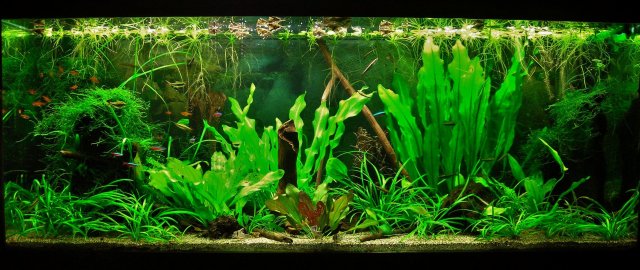I've got pretty basic LED's on my planted tanks. I leave them on 10-12 hours and dose ferts.
Sent from my iPhone using MonsterAquariaNetwork app
Sent from my iPhone using MonsterAquariaNetwork app
This is going to be difficult if not impossible for any of us to answer unless you can decide on CO2 or not first. Lighting must be balanced with the available nutrients of which CO2 (carbon) is one, otherwise you will have a tank of algae with either too little or too much light.Still hoping for some recommendations on the correct lighting for the tank. That's the only thing holding me up from getting started now.
First on the Excel, I cannot recommend this. It consists of glutaraldehyde (and water), and this is a very toxic disinfectant used in hospitals, anti-freeze, embalming fluid, and elsewhere to kill bacteria. Even when used at the dose recommended on the label, it usually kills Vallisneria and some mosses outright. If it should be overdosed, it can kill plants, fish and bacteria. Given that there is a fair bit of CO2 naturally occurring, this risk seems unwise. And, it will again raise the balance with the light and other nutrients.My apologies. I didn't realize that the choice of CO2 additive changed the lighting requirement so much. For my first attempt at this I've decided to go with Flourish Excel rather the diffused CO2. Given that, you mentioned a comprehensive liquid fertilizer that you use. Which one do you use? I was planning on using the below guide (found in the sticky above) and purchasing the dry fertilizer from aquariumfertilizer.com (also recommended in the sticky). Is that guide more geared towards high tech set ups?
20-40 Gallons
1/4 tsp KNO3 3x a week
1/16 tsp KH2PO4 3x a week
1/16 tsp K2SO4 3x a week
1/16 tsp (5ml) traces 3x a week

HybridHerp and I were posting at the same time, and he/she has presented more good info. Except for the Excel, I agree, just so you know. PAR is something I have never bothered with simply for the reason given there, that many tubes/bulbs do not tell us this. However, it can help when you have it.I've read a lot about many of these topics and I've never come across anything so negative about the Flourish Excel. Assuming I don't use that, what kind of light would be required and how long should it be on per day? Thanks for the info on the liquid fertilizers. That seems like themuch easier way to go.
Would it be overkill if I used a base of this organic potting soil and then topped it with this substrate?For starters, I would recommend having a nutritious substrate to begin with. Such as mineralized top soil (if you have the time and means to read how to make that...or if you find someone selling it) or using organic potting mix and dealing with the nutrients spikes and longer cycling, topped with sand.
I rather doubt it. I found the manufacturer's web site:I'm fish first for sure and a healthy tank of live plants is obviously the best environment for fish. But I'm also obsessed with some of the beautiful aquascapes that I've been looking at. Do you think this light would be sufficient for what we've talked about?





